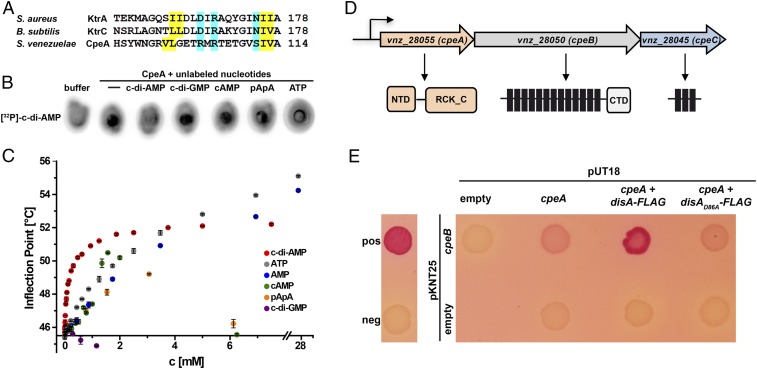Fig. 6.
CpeA (Vnz_28055) binds c-di-AMP and interacts with CpeB (Vnz_28050) in a c-di-AMP-stimulating manner. (A) Alignment of the c-di-AMP binding regions in RCK_C domains was generated using Clustal Omega (49). C-di-AMP binding residues in KtrA (S. aureus; ref. 50), KtrC (B. subtilis; ref. 51), and conserved amino acids in CpeA are highlighted. Amino acids that form the hydrophobic patch are shown in yellow; residues involved in hydrophilic coordination are highlighted in cyan. (B) CpeA binds [32P]-c-di-AMP in DRaCALAs. Binding of the radiolabeled ligand is indicated by dark spots centered on the nitrocellulose. In competition assays, excess (100 µM) of unlabeled c-di-AMP, c-di-GMP, cAMP, 5′-pApA, or ATP was added to the binding reaction containing [32P]-c-di-AMP and 6xHis-CpeA. (C) Inflection points from nanoDSF thermal shift assays of 20 µM CpeA with different concentrations of c-di-AMP, ATP, AMP, cAMP, 5′-pApA, and c-di-GMP (0 to 10 mM) at a heating rate of 1.5 K/min. Shown are mean values of n = 3 independent experiments with SD. (D) cpeA (vnz_28055), cpeB (vnz_28050) and cpeC (vnz_28045) form an operon in S. venezuelae. CpeA has an N-terminal domain (NTD) of unknown function and a C-terminal RCK_C domain. CpeB is a predicted structural homolog of the Na+/H+ antiporter NapA (36). It consists of 13 transmembrane (TM) domains and a cytosolic fraction at the C terminus (CTD). CpeC is a predicted membrane protein with 3 TM domains. (E) Adenylate cyclase–based two-hybrid assays revealing that CpeA and CpeB interact in vivo and that c-di-AMP production by coexpressed DisA-FLAG stimulates protein–protein interaction. Using pKNT25 and pUT18, the T25 and T18 fragments of adenylate cyclase were attached to the C termini of CpeB and CpeA, respectively. disA-FLAG and disAD86A-FLAG were expressed from pUT18-cpeA. The leucin zipper part of the yeast GCN4 protein was used as a positive control. Spotted cotransformants were grown for 24 h at 26 °C.

